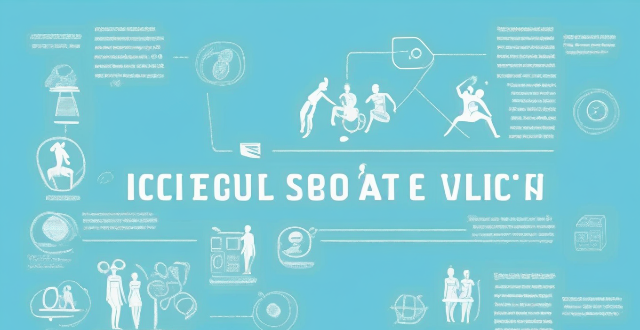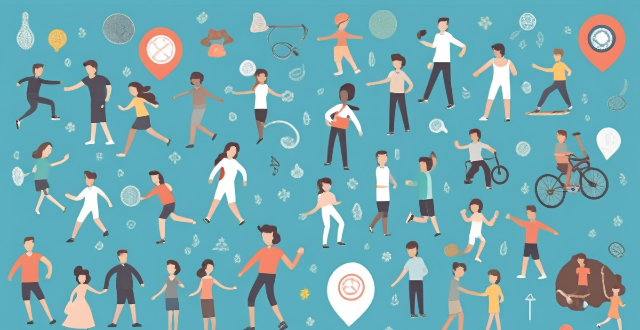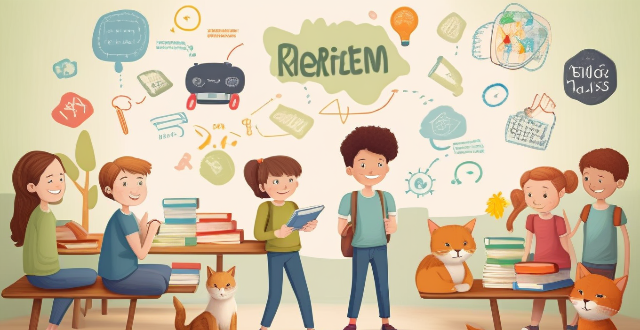Sports Inclusion

How does sports contribute to social inclusion ?
Sports have the power to promote social inclusion by breaking down barriers, promoting teamwork, providing opportunities for participation, building confidence and self-esteem, and promoting health and wellbeing.

What role do sports play in promoting diversity and inclusion in society ?
The text discusses the various ways in which sports can contribute to promoting diversity and inclusion. This includes breaking down stereotypes and prejudices, highlighting achievements of underrepresented groups, providing equal opportunities, fostering cultural exchange, encouraging respect and fair play, and promoting health and wellness for all. It emphasizes that sports serve as a powerful vehicle for promoting diversity and inclusion in society by breaking down barriers, providing equal opportunities, fostering cultural exchange, encouraging respect and fair play, and promoting health and wellness for all.

How do urban policies address issues of access and inclusion in sports facilities ?
Urban policies are crucial in addressing access and inclusion in sports facilities. They can promote this through public funding and investment, community engagement, equitable distribution, and promotion of diversity and inclusion. Examples include constructing public parks, upgrading existing facilities, conducting community surveys, partnering with local organizations, implementing zoning regulations, introducing mobile sports programs, establishing gender-specific facilities, and offering culturally sensitive programs.

What are some examples of successful initiatives that use sports to promote social inclusion ?
This text discusses successful initiatives that use sports to promote social inclusion. It highlights five examples of such initiatives: Street Football World, Homeless World Cup, Wheelchair Basketball Initiatives, Sporting Equals, and Gender Equality in Sports Programs. These initiatives aim to unite people through football, inspire homeless people, promote disability inclusion, challenge discrimination in British Asian communities, and encourage women's participation in various sports, respectively. The activities include global tournaments for marginalized communities, international tournaments for homeless teams, local wheelchair basketball leagues, community cricket events, and women's sports leagues. The impact of these initiatives is significant, with increased public awareness about homelessness, personal transformation stories of participants, improved physical fitness and self-esteem among disabled individuals, reduced instances of racism and discrimination in sport, and higher visibility and recognition of women in sports.

To what extent does the globalization of sports contribute to social equality and inclusion ?
The globalization of sports has led to increased opportunities for athletes from different backgrounds and cultures, but also poses challenges to social equality and inclusion. Efforts are needed to address these challenges and promote fairness, inclusivity, and respect for all athletes.

How does Fintech impact financial inclusion ?
Fintech has revolutionized financial services, making them more accessible and affordable. It has increased accessibility for unbanked populations, lowered costs, improved efficiency, driven innovation, enhanced security, promoted financial literacy, facilitated inclusion initiatives, enabled digital identity verification, supported microfinance and crowdfunding, and promoted mobile money and payment systems. These advancements have significantly impacted financial inclusion worldwide.

What role does sports play in promoting cultural diversity and inclusion ?
Sports play a significant role in promoting cultural diversity and inclusion by breaking down barriers, educating about different cultures, building communities, and contributing positively to economic development.

What role do sports stars and influencers have in promoting social inclusion and diversity ?
The role of sports stars and influencers in promoting social inclusion and diversity is significant. They break down barriers by enhancing visibility and representation of diverse groups, serve as positive role models, promote inclusive practices in sports, and drive social change through collaborations and partnerships. Their actions help create an accepting and inclusive society where everyone feels valued and respected regardless of their background or identity.

What is social inclusion and why is it important ?
Social inclusion refers to the process of ensuring that all individuals can participate in all aspects of society. It aims to create a society where everyone feels valued, regardless of their background. Key elements include equal opportunities, non-discrimination, participation, empowerment, and solidarity. Social inclusion is important for promoting equity and fairness, enhancing economic growth, improving health and well-being, reducing poverty and exclusion, enhancing social cohesion, and supporting sustainable development.

How can non-disabled individuals support and advocate for greater inclusion and opportunities in sports for people with disabilities ?
Non-disabled individuals can promote inclusion and create equal opportunities in sports for people with disabilities by understanding the issues, spreading information, actively participating, advocating for policy change, promoting role models, and engaging in personal interaction.

How do these education policy updates address issues related to diversity and inclusion ?
Education policy updates are crucial for addressing diversity and inclusion in schools. They aim to create an equitable learning environment that caters to the needs of all students, regardless of their background or identity. These updates contribute to promoting diversity and inclusion by recognizing and valuing diverse perspectives, providing access to education for all students, promoting cultural competency among educators, encouraging inclusive curriculum design, addressing bias and stereotyping, and supporting special education needs. By implementing these policies, schools can create a more equitable and inclusive learning environment that benefits all students, regardless of their background or identity.

Can sports psychology improve team dynamics and cohesion ?
The text discusses the role of sports psychology in enhancing team dynamics and cohesion. Sports psychology can improve communication, build trust, promote collaboration, manage conflict, create a shared vision, foster resilience, encourage social support, and promote diversity and inclusion among team members. These interventions lead to better understanding, reduced misunderstandings, increased support and reliability, effective collaboration, constructive conflict management, a unified purpose, improved coping strategies, emotional comfort and encouragement, and an inclusive culture. Overall, sports psychology plays a crucial role in improving team dynamics and cohesion, leading to greater success for athletes and teams.

What impact do sports-related charitable activities have on local communities ?
Sports-related charitable activities have a significant impact on local communities by promoting physical fitness, enhancing civic pride, providing educational opportunities, fostering diversity and inclusion, and addressing social issues. These activities bring people together, teach valuable life skills, and promote healthy lifestyles among children and young adults. By getting involved in sports-related charitable activities, we can make a positive difference in our local communities and create a brighter future for all.

How can schools and communities create inclusive sports programs for children with disabilities ?
Inclusive sports programs are important for children with disabilities. To create such programs, schools and communities should assess community needs, develop policies and procedures, train coaches and staff, modify facilities and equipment, offer modified sports programs, promote inclusion and participation, and evaluate and improve continuously. This ensures equal opportunities for children with disabilities to engage in physical activities and personal growth while fostering a sense of belonging and inclusion.

How do sports events promote social interaction and community building ?
Sports events play a significant role in promoting social interaction and community building. They bring people together, foster a sense of belonging, and create opportunities for individuals to connect with one another. This is achieved through encouraging participation, building community spirit, providing entertainment and recreation, facilitating networking opportunities, and enhancing diversity and inclusion. By bringing people together around a shared passion for sports, these events create lasting connections and positive experiences that extend far beyond the playing field.

What role do sports organizations play in fostering community engagement and participation ?
The text discusses the role of sports organizations in fostering community engagement and participation. It highlights their contributions in various areas including community building, educational outreach, economic impact, and social responsibility. Sports organizations promote social interaction by offering memberships, organizing events, and providing volunteer opportunities. They enhance diversity and inclusion through inclusive policies, adaptive sports programs, and cultural celebrations. In terms of educational outreach, they promote health and wellness through fitness programs, workshops, and school collaborations. They also develop life skills such as leadership, character development, and career opportunities. Sports organizations stimulate local economies by hosting tournaments and events, promoting sports tourism, and creating jobs. They support local businesses through partnership programs, community marketplaces, and merchandise sales. Additionally, sports organizations demonstrate social responsibility by adopting green initiatives, planning eco-friendly events, launching educational campaigns, organizing fundraising events, having athlete ambassadors, and offering matching gift programs. Overall, sports organizations play a crucial role in building social connections, enhancing diversity and inclusion, providing educational outreach, stimulating local economies, and embracing social responsibility.

How can local communities promote inclusion and diversity to support immigrant integration ?
Local communities can promote inclusion and diversity to support immigrant integration by implementing educational programs, organizing community events, providing accessible services, partnering with immigrant organizations, and advocating for policy change. These efforts can create a welcoming environment where immigrants can thrive and contribute to the community.

How do sports organizations ensure they are inclusive and respectful of cultural differences among athletes ?
Sports organizations play a crucial role in promoting inclusivity and respecting cultural differences among athletes. This is achieved through various means, such as implementing anti-discrimination policies, providing cultural education and training, encouraging diversity in coaching and leadership roles, acknowledging cultural celebrations and holidays, providing resources for cultural integration, creating safe spaces for open dialogue, partnering with community organizations, and monitoring and evaluating progress.

How can writers use sports as a metaphor for larger societal issues ?
The text provides a guide on how writers can use sports as a metaphor to explore larger societal issues. The playing field in sports is likened to a microcosm of society, where fairness, equality, and justice are examined. Teamwork and collaboration in sports are used to discuss cooperation, diversity, and inclusion in society. The competitive nature of sports serves as a metaphor for the drive for success, ambition, perseverance, and the cost of success. Rules and ethics in sports are compared to societal laws and ethical standards, discussing corruption, cheating, and the importance of maintaining integrity. Finally, overcoming adversity in sports is used as a platform for stories of hope and resilience in the face of societal challenges.

What are some adaptive sports for people with physical disabilities ?
Adaptive sports are modified or specially designed physical activities for people with disabilities, promoting fitness, health, and inclusion. They offer opportunities for competition and social interaction. Popular adaptive sports include wheelchair basketball, racing, and tennis; sitting volleyball; para swimming; track and field events for amputees; goalball; para alpine skiing; and beep baseball for the visually impaired. These sports provide physical benefits and opportunities for personal growth, independence, and social integration.

How do gender biases affect coaching and leadership positions within sports teams and organizations ?
Gender biases in sports coaching and leadership positions manifest as discrimination against women, stereotyping of female coaches, and limited opportunities for women. These issues can be addressed by implementing diversity policies, providing mentorship programs, encouraging cultural change, and promoting transparency and accountability within sports organizations.

What are some examples of successful disability sports organizations or events around the world ?
Disability sports have been gaining popularity and recognition worldwide, with many organizations and events showcasing the talent and determination of athletes with disabilities. Here are some examples of successful disability sports organizations and events around the world: 1. Paralympic Games: An international multi-sport event for athletes with physical and intellectual disabilities, held immediately after the Olympic Games in the same host city. 2. Special Olympics World Games: A global event for athletes with intellectual disabilities, offering competition in various sports such as swimming, athletics, and basketball. 3. International Wheelchair Basketball Federation (IWBF): The governing body for wheelchair basketball worldwide, organizing international competitions and promoting the development of wheelchair basketball across different regions. 4. Cerebral Palsy Football World Cup: A biennial international football tournament for players with cerebral palsy, providing an opportunity for these athletes to showcase their skills and promote awareness about cerebral palsy. 5. International Blind Sports Association (IBSA): Dedicated to promoting sports for visually impaired athletes, organizing world championships and other events in various sports such as goalball, judo, and swimming. 6. World Deaf Volleyball Championships: An international competition for deaf volleyball players, promoting the development of deaf sports and providing a platform for deaf athletes to showcase their talent and compete at the highest level. 7. World Dwarf Games: A multi-sport event specifically designed for individuals with dwarfism, offering a range of sports such as swimming, track and field, and powerlifting, providing opportunities for athletes with dwarfism to compete and showcase their abilities.

How have historical events impacted the acceptance and participation of women in various sports throughout time ?
The text discusses how historical events and societal norms have influenced women's participation in sports throughout history. In ancient civilizations like Greece and Rome, women were generally excluded from athletic competitions due to cultural beliefs and expectations about their roles. During the Middle Ages, their involvement remained limited, with some exceptions for practical purposes. The Industrial Revolution brought slight progress as leisure time increased, but gender stereotypes still hindered women's participation. Pioneering figures in the late 19th and early 20th centuries began promoting women's sports, leading to the inclusion of women's events in the Olympics. After World War II, there was a push for gender equality, including in sports, resulting in increased opportunities for female athletes. Today, while women participate in a wider range of sports than ever before, challenges such as unequal treatment persist, requiring continued advocacy for gender equity in sports.

What is the role of sports sponsorship in promoting gender equality in sports ?
Sports sponsorship is crucial for promoting gender equality in sports. It provides financial support to female athletes, increases visibility of women's sports, creates role models, and promotes equity by ensuring equal funding for both men's and women's sports. This helps break down barriers and create opportunities for female athletes to compete at the highest levels.

Can sports be used as a tool for breaking down social barriers and promoting equality ?
The power of sports to bring people together and foster a sense of community is undeniable. However, the question remains: can sports be effectively utilized as a tool for breaking down social barriers and promoting equality? Sports organizations are increasingly recognizing the importance of diversity both on the field and off. By actively recruiting athletes from different backgrounds, sports can serve as a visible symbol of inclusion. Through exposure to diverse teams and athletes, sports can help dispel stereotypes and prejudices, encouraging fans and participants alike to appreciate the unique talents and contributions of individuals regardless of their background. Participation in sports teaches valuable life skills such as teamwork, discipline, and perseverance, which can be instrumental in overcoming social barriers. Success in sports can empower individuals, particularly women and minorities, by providing a platform for them to showcase their abilities and achieve recognition. Major sporting events can stimulate local economies by creating jobs and promoting tourism. Investments in sports facilities can revitalize neglected areas, providing much-needed resources and encouraging further development. Grassroots sports programs can engage community members, fostering a sense of belonging and pride that extends beyond the playing field. Unequal distribution of resources can hinder the ability of some communities to fully participate in sports. Physical accessibility for athletes with disabilities remains a crucial issue that needs to be addressed comprehensively. Ensuring equal opportunities and treatment for female athletes continues to be a focal point in the fight for equality in sports. Efforts to promote diversity must be genuine and avoid tokenism, ensuring that all participants feel valued and respected. Organizations must continuously assess their progress toward inclusivity and make necessary adjustments to maintain effectiveness. Educating stakeholders about the importance of inclusivity and equity is essential for maintaining momentum and driving change.

How can we ensure that sports are accessible and inclusive for people of all backgrounds and abilities ?
The text discusses the importance of ensuring accessibility and inclusivity in sports for people of all backgrounds and abilities. It outlines various strategies to achieve this, including identifying and addressing barriers such as physical, financial, and cultural accessibility; promoting equality and fairness through policies, legislation, education, and training; empowering individuals through participation in community sports programs and media representation; and measuring success through evaluation, feedback mechanisms, research, and development. The goal is to create an environment where everyone has the opportunity to participate and enjoy the benefits of sports.

How do sports boycotts or bans reflect on international relations ?
Sports boycotts or bans are often used as a political tool to express disapproval or to exert pressure on another country. These actions can have significant implications for international relations, as they can be seen as a form of diplomatic action. This essay explores how sports boycotts or bans reflect on international relations and the potential consequences that may arise from such actions. Sports boycotts or bans are often used as a form of protest against perceived injustices or violations of human rights, political disagreements, or other issues that may affect international relations. Historical examples include the African nations' boycott of the 1972 Summer Olympics due to Rhodesia's inclusion, the US-led boycott of the 1980 Summer Olympics in Moscow to protest the Soviet Union's invasion of Afghanistan, and calls for sports boycotts against China over its treatment of Uighur Muslims in Xinjiang province. Sports boycotts or bans can create diplomatic tensions between countries, leading to further escalation of conflicts. They can also have economic consequences for both the host country and participating athletes, as well as limit opportunities for cultural exchange and global unity. As such, it is important for countries to carefully consider the potential consequences before engaging in sports boycotts or bans as a form of political protest.

How do gender stereotypes affect female adolescents' participation in sports ?
Gender stereotypes have a significant impact on female adolescents' participation in sports. These stereotypes can limit opportunities, discourage participation, and create barriers to success for young women in athletics. In this article, we will explore the ways in which gender stereotypes affect female adolescents' involvement in sports and discuss strategies for promoting gender equality in sports. One of the most significant ways that gender stereotypes affect female adolescents' participation in sports is by limiting their opportunities. Many schools and sports organizations still prioritize male athletes over female athletes, resulting in fewer resources and opportunities for girls to participate in sports. This can lead to a lack of access to quality coaching, training facilities, and equipment, as well as limited opportunities to compete at higher levels. Gender stereotypes also discourage female adolescents from participating in sports by perpetuating harmful beliefs about women's abilities and interests. These beliefs suggest that sports are not appropriate or desirable for girls, leading many young women to avoid athletic activities altogether. Additionally, some girls may feel pressured to conform to traditional gender roles, which often do not include participation in sports. Even when female adolescents do participate in sports, gender stereotypes can create barriers to their success. These barriers include discrimination, biased expectations, and unequal treatment compared to male athletes. For example, some coaches may have lower expectations for female athletes or provide less support and encouragement than they would for male athletes. Additionally, female athletes may face discrimination from opponents, officials, or even their own teammates. To combat the negative effects of gender stereotypes on female adolescents' participation in sports, it is essential to promote gender equality in athletics. Some strategies for achieving this goal include providing equal opportunities and resources for both male and female athletes; encouraging all students to participate in sports regardless of gender; educating coaches, parents, and peers about the benefits of sports for female adolescents; addressing discriminatory behavior and creating a culture of respect and inclusion within sports organizations; and celebrating the achievements of female athletes through media coverage and recognition events.

How might the inclusion of sports improve social dynamics and reduce bullying in schools ?
The role of sports in improving social dynamics and reducing bullying in schools is significant. Sports encourage teamwork, collaboration, leadership skills, respect, and discipline among students. They promote empathy, understanding, and positive competition while providing a supportive community for all students. Incorporating sports into the school curriculum can create a positive environment where students can thrive both physically and mentally.

How does social inclusion relate to diversity and multiculturalism ?
The article discusses the relationship between social inclusion, diversity, and multiculturalism. It defines each concept and explains their importance in promoting equality, participation, and belonging. The article also highlights the benefits of diversity and multiculturalism, such as enhanced creativity and understanding among different cultural groups. The intersectionality of these concepts is explored, along with examples of inclusive policies and practices. Education is emphasized as a crucial tool for promoting social inclusion, diversity, and multiculturalism. Overall, the article concludes that these interconnected concepts are essential for building a more equitable and harmonious society.